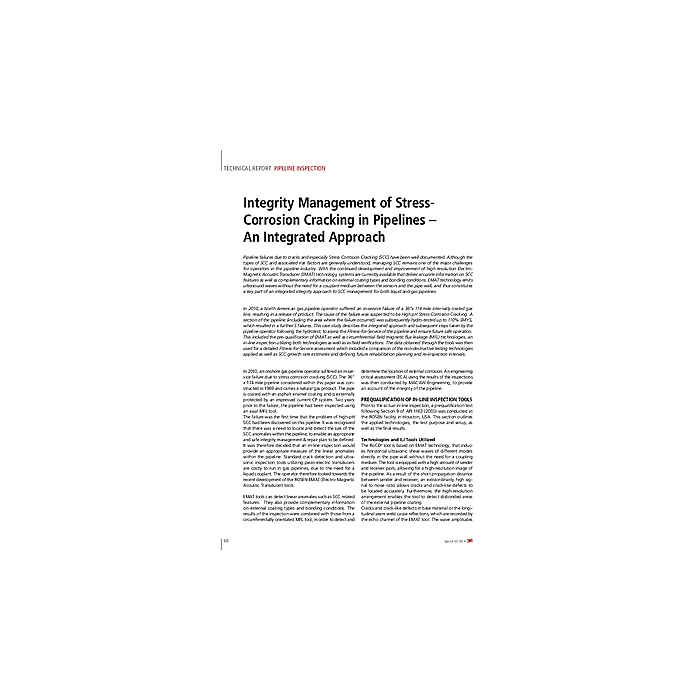Integrity Management of Stress-Corrosion Cracking in Pipelines – An Integrated Approach
€4.90
In stock
article number
01252_2014_SP2_10
Pipeline failures due to cracks and especially Stress Corrosion Cracking (SCC) have been well documented. Although the types of SCC and associated risk factors are generally understood, managing SCC remains one of the major challenges for operators in the pipeline industry. With the continued development and improvement of high resolution Electro-Magnetic Acoustic Transducer (EMAT) technology, systems are currently available that deliver accurate information on SCC features as well as complementary information on external coating types and bonding conditions. EMAT technology emits ultrasound waves without the need for a couplant medium between the sensors and the pipe wall, and thus constitutes a key part of an integrated integrity approach to SCC management for both liquid and gas pipelines. In 2010, a North American gas pipeline operator suffered an in-service failure of a 36”x 114 mile internally coated gas line, resulting in a release of product. The cause of the failure was suspected to be High pH Stress Corrosion Cracking. A section of the pipeline (including the area where the failure occurred) was subsequently hydro-tested up to 110% SMYS, which resulted in a further 5 failures. This case study describes the integrated approach and subsequent steps taken by the pipeline operator following the hydrotest, to assess the Fitness-for-Service of the pipeline and ensure future safe operation. This included the pre-qualification of EMAT as well as circumferential field magnetic flux leakage (MFL) technologies, an in-line inspection utilizing both technologies as well as in-field verifications. The data obtained through the tools was then used for a detailed Fitness-for-Service assessment which included a comparison of the non-destructive testing technologies applied as well as SCC growth rate estimates and defining future rehabilitation planning and re-inspection intervals.
| Authors | Markus Ginten / Tom Penney / Iain Richardson / Andy Russell |
|---|---|
| Publishing Date | 29 Aug 2014 |
| Format | |
| Zeitschrift | 3R - Special 2 2014 |
| Publisher | Vulkan-Verlag GmbH |
| Language | English |
| Pages | 7 |
| Title | Integrity Management of Stress-Corrosion Cracking in Pipelines – An Integrated Approach |
| Description | Pipeline failures due to cracks and especially Stress Corrosion Cracking (SCC) have been well documented. Although the types of SCC and associated risk factors are generally understood, managing SCC remains one of the major challenges for operators in the pipeline industry. With the continued development and improvement of high resolution Electro-Magnetic Acoustic Transducer (EMAT) technology, systems are currently available that deliver accurate information on SCC features as well as complementary information on external coating types and bonding conditions. EMAT technology emits ultrasound waves without the need for a couplant medium between the sensors and the pipe wall, and thus constitutes a key part of an integrated integrity approach to SCC management for both liquid and gas pipelines. In 2010, a North American gas pipeline operator suffered an in-service failure of a 36”x 114 mile internally coated gas line, resulting in a release of product. The cause of the failure was suspected to be High pH Stress Corrosion Cracking. A section of the pipeline (including the area where the failure occurred) was subsequently hydro-tested up to 110% SMYS, which resulted in a further 5 failures. This case study describes the integrated approach and subsequent steps taken by the pipeline operator following the hydrotest, to assess the Fitness-for-Service of the pipeline and ensure future safe operation. This included the pre-qualification of EMAT as well as circumferential field magnetic flux leakage (MFL) technologies, an in-line inspection utilizing both technologies as well as in-field verifications. The data obtained through the tools was then used for a detailed Fitness-for-Service assessment which included a comparison of the non-destructive testing technologies applied as well as SCC growth rate estimates and defining future rehabilitation planning and re-inspection intervals. |
Write Your Own Review

